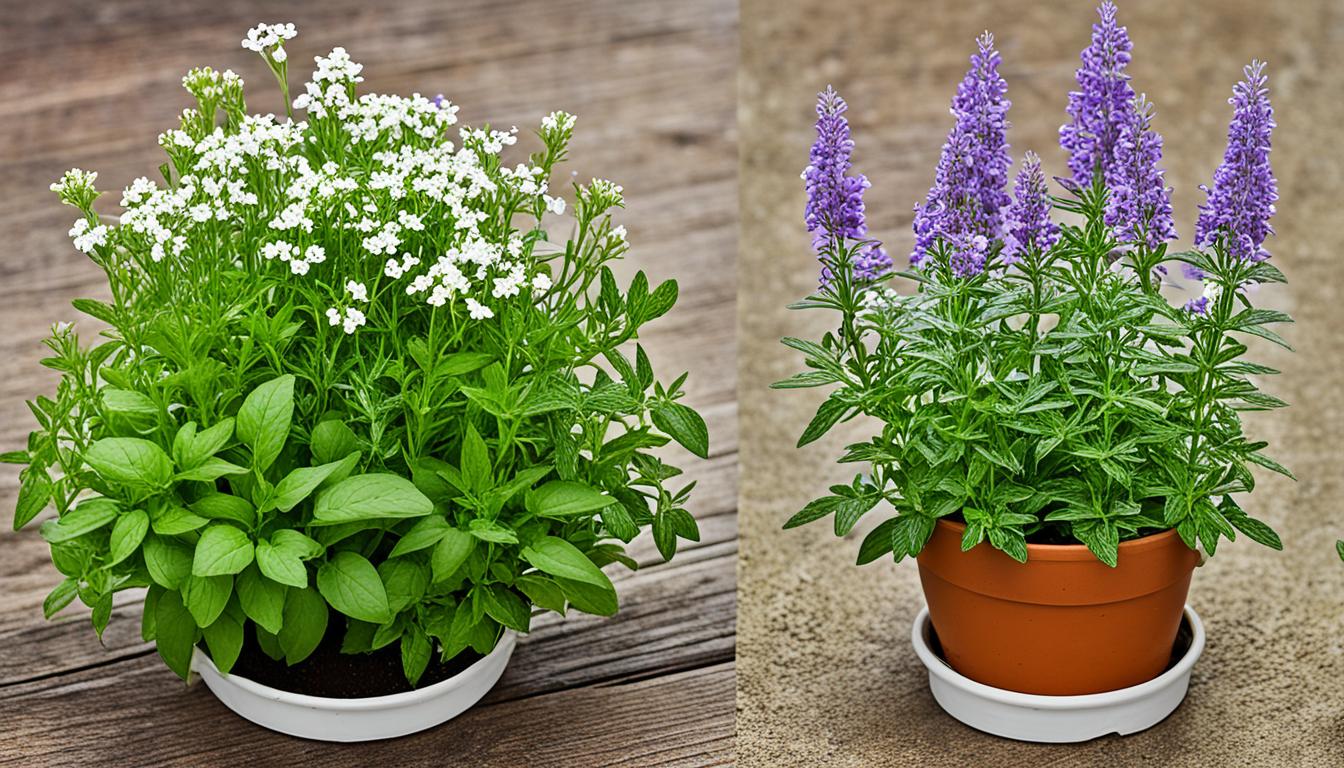At first look, green onions and chives might seem the same. But they are different in many ways. Knowing these differences helps you choose the right one for your cooking. We’ll look into what makes chives and green onions special. This includes their uses, flavors, and growing tips.
Key Takeaways:
- Chives and green onions are not the same; they’re used differently in cooking.
- Chives are soft herbs with a gentle onion taste. They’re often used for decoration or to add a light onion flavor.
- Green onions, or scallions, are strong-tasting vegetables. They’re great in stir-fries, soups, and salads.
- You can grow both chives and green onions in your garden. This gives you fresh ingredients for your meals.
- Remember the unique traits of chives and green onions in your recipes. They can make your food taste and look better.
Chives: Delicate Herb with Unique Flavor
Chives are a wonderful herb that brings freshness to many dishes. They are thin, green, and part of the Allium family, which includes onions and garlic. Chives taste mildly like onions, adding a nice flavor to salads, soups, and more.
The Art of Growing Chives
Growing chives can be very rewarding. It’s easy to grow them in gardens or in pots. They need sun but can grow in some shade too. You can start with seeds or buy young plants from a nursery.
“Chives can be grown in different varieties, such as common chives, garlic chives, and Siberian chives, each with slight variations in taste and appearance.”
To plant chive seeds, put them in a shallow trench and cover lightly with soil. Water them lightly. Keep the soil moist until they sprout, which should take about 1-2 weeks. As they grow, make sure each plant has enough room.
Harvesting Chives
When chives are 6-8 inches tall, they are ready to pick. Cut the leaves near the ground, leaving 2 inches so they can grow back. Be careful not to cut them too short. Cutting them regularly helps them grow better and gives you fresh chives.
Culinary Uses of Chives
Chives are used worldwide for their gentle flavor and bright color. They are perfect for topping soups, salads, omelets, and potatoes. Chives add a light onion flavor to dressings, dips, and sauces without taking over the taste of the dish.
Here are some ways to use chives:
- Add chopped chives to scrambled eggs for a burst of freshness.
- Sprinkle chives over grilled fish or roasted vegetables.
- Mix chives into cream cheese for a flavorful spread.
- Stir chives into sour cream for a tangy dip.
- Garnish soups, pastas, and risottos with a sprinkle of chives.
Chives improve the taste and look of your food, making any dish special.
Chives: A Versatile Herb
Chives are great for cooking and offer more benefits. They help fight germs and can improve your health. In gardens, their smell keeps pests away from other plants.
| Chives | Green Onions |
|---|---|
| Mild onion flavor | Pungent onion flavor |
| Thin and fragile | Thicker and sturdier |
| Used as a garnish and for subtle onion taste | Used in cooking and for stronger onion flavor |
| Harvested by cutting the leaves near ground level | Harvested by pulling the entire plant from the ground |
Chives add a delicate touch and visual appeal to dishes. They are unique and essential for those who love cooking.
Green Onions: Versatile Vegetable with a Pungent Flavor
Green onions, also known as scallions, are a multipurpose veggie. They boost the taste of many dishes.
With slender stems and a white and green color, they have a gentler flavor than big onions. The white part packs more punch, but the green part tastes fresher.
Green onions work wonders in various recipes. They can be cooked or raw. They add a special flavor to stir-fries, soups, and salads.
Add chopped green onions to a bowl of soup for extra taste. Or sprinkle them on grilled meats. They can even be mixed into homemade salsa for freshness.
Not just tasty, green onions make your food look great. Their bright green color brings life to any plate.
So, don’t hesitate to use green onions, whether you’re new to cooking or an expert. They’re key for upping your food game.
Appearance and Texture Differences
Chives and green onions stand out in looks and feel. These qualities affect their cooking uses and how they enhance a meal’s taste and texture.
Appearance wise, chives are thin with solid green stems. They look elegant and add sophistication as a garnish. In contrast, green onions have thicker stems that change color from white to green. This adds an interesting look and depth to food.
Regarding texture, chives add a mild crunch that’s perfect for salads and soups. They make dishes more enjoyable with their fresh feel. Green onions, though, have a different texture. Their white parts are crunchy, but the green parts are softer. This mix adds to the fun in stir-fries, omelets, and salsas.
“The appearance and texture of chives and green onions can transform a dish, enhancing both its visual appeal and mouthfeel.”
Look at this table to understand the visual and textural differences between chives and green onions:
| Appearance | Texture | |
|---|---|---|
| Chives | Thin, solid green stems | Mild crunch |
| Green Onions | Thicker stems transitioning from white to green | Crunchy white part, softer green tops |
These differences make chives and green onions unique for cooking. Whether you want the elegance of chives or the crunch of green onions, both enhance your food.
Culinary Applications
The looks and feel of chives and green onions shape how they’re used in cooking. Chives are great for garnishing and adding flavor. Green onions are versatile and suit many cooked dishes.
Flavor Profile and Culinary Uses
Chives and green onions have unique tastes. They add flavor to many dishes. Knowing their flavors helps you choose correctly for your meals.
Chives: Mild and Herbaceous
Chives offer a mild, herby taste. They are great for adding a gentle onion flavor to food. Use them to garnish and enhance the look of your dishes.
They’re perfect for salads, omelets, and baked potatoes. Chives also boost creamy dips, dressings, and sauces with freshness.
Green Onions: Bold and Pungent
Green onions have a bold, strong onion flavor. They stand out in cooked meals where you want a noticeable onion taste. They work well in stir-fries, soups, and stews.
Add them to grilled meats for extra flavor. They also enhance sauces and marinades with their pungent taste.
“Chives add a mild onion taste, while green onions bring a bolder flavor to your dishes.”
Culinary Uses
Chives and green onions suit different cooking needs. Their intensity and texture vary:
- Chives are good for fresh dishes like salads. They add a light onion scent.
- Green onions fit both cooked and raw meals. Use them in stir-fries, soups, or as taco toppings.
Both chives and green onions enhance recipes uniquely. They allow you to explore new flavors.
| Culinary Uses | Chives | Green Onions |
|---|---|---|
| Garnish | ✔️ | ✔️ |
| Salads | ✔️ | ✔️ |
| Dressings | ✔️ | ✔️ |
| Soups and stews | ❌ | ✔️ |
| Stir-fries | ❌ | ✔️ |
| Sauces | ❌ | ✔️ |
Nutritional Comparison
Chives and green onions share many nutritional benefits. They’re both low in calories and fat. Plus, they’re filled with vital vitamins and minerals.
Chives have more calcium, folate, and vitamin A than green onions. This makes chives a great choice for increasing your nutrient intake.
Let’s look at the key vitamins and minerals in chives and green onions:
| Nutrient | Chives | Green Onions |
|---|---|---|
| Calcium | Higher Amount | Lower Amount |
| Folate | Higher Amount | Lower Amount |
| Vitamin A | Higher Amount | Lower Amount |
| Vitamin C | Similar Amounts | Similar Amounts |
| Potassium | Similar Amounts | Similar Amounts |
Even though chives and green onions are different nutritionally, they’re usually used as garnishes. So, the nutritional variations might not greatly affect your diet.
Adding both chives and green onions to your meals is smart. They make your food tastier and boost its nutritional value.
Storage and Shelf Life
It’s key to store chives and green onions right to keep them fresh. Let’s learn how to store these herbs properly. This will make sure they’re tasty and ready when you need them.
Chives
Chives need careful handling to stay flavorful. Here are steps to keep them fresh longer:
- Trim the roots of the chives and remove any wilted or discolored leaves.
- Gently wash the chives under cold water and pat them dry with a paper towel.
- Wrap the chives in a damp paper towel to keep them hydrated.
- Place the wrapped chives in a resealable plastic bag or an airtight container.
- Store the chives in the refrigerator.
Tip: Chives go bad quickly and are best used soon after buying. With the right storage, they can stay fresh for about a week.
Green Onions
Green onions, or scallions, last longer than chives. To keep them fresh, follow these steps:
- Trim the root ends of the green onions and remove any damaged or yellowed tops.
- Rinse the green onions under cold water and pat them dry with a paper towel.
- Wrap the green onions in a slightly damp paper towel to maintain moisture.
- Place the wrapped green onions in a resealable plastic bag or an airtight container.
- Store the green onions in the refrigerator.
Tip: Green onions can stay fresh for over a week with proper storage. For more convenience, cut them in advance and keep them in the fridge.
Good storage and care are key to keeping chives and green onions fresh and tasty. By using these tips, you’ll always have these herbs ready in top condition.
Growing Your Own Chives and Green Onions
If you love gardening and cooking, try growing chives and green onions. They’ll give you fresh ingredients. Plus, you’ll enjoy watching your plants grow and flourish. Let’s learn how to grow them in your garden.
Growing Chives
Chives are pretty and easy to grow perennials. Pick a sunny place with soil that drains well. Even though chives love sunlight, they can do well in a bit of shade too. Start them from seeds or get young plants from a garden center.
To plant chive seeds, put them 1/4 inch deep in the soil. Whether in your garden or a pot, leave 8 inches between seeds or plants. Chives need water, especially when it’s dry. But don’t overdo it; their soil should be moist, not wet.
Take off any flowers you see growing on the chives during the season. This helps grow more tasty leaves. Cut the stems close to the ground to harvest. The plant will keep growing, giving you more to use later.
Growing Green Onions
Green onions add great taste to dishes and are simple to grow. They like sunny spots and well-drained soil, just like chives. Start them from seeds or plant the bottoms of ones you’ve bought.
For seeds, plant them 1/2 inch deep. For bulbs, just cover them with soil but leave the top out. Keep their soil moist with regular watering.
Harvest them when they’re as thick as a pencil. Pull them gently, clean off soil, and wash them before using.
Benefits of Growing Your Own Chives and Green Onions
“Growing chives and green onions yourself is rewarding. It connects you to nature and gives your cooking fresh flavors. You’ll have your own organic supply and cut down on buying from stores. Plus, they’ll make your garden look and smell amazing!”
Summary
Growing your own chives and green onions is great for your kitchen and garden. With some care, they provide a steady source of taste and freshness. Chives and green onions can make any dish special, sharing their flavors and health benefits.
Conclusion
In summary, chives and green onions are quite different. Chives offer a mild onion flavor with a subtle crunch. Green onions have a bolder onion flavor and provide a mix of textures.
Knowing the differences between chives and green onions helps in cooking. Whether you want a delicate crunch or a strong flavor, each has special traits. They add depth to your cooking.
Next time at the store or planning your garden, think about chives and green onions. Try using their distinct flavors and looks to boost your cooking and garnishing. Adding chives or green onions to recipes brings oniony goodness that improves everything.





